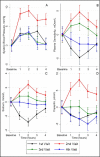Acute effects of salt on blood pressure are mediated by serum osmolality
- PMID: 30232829
- PMCID: PMC8030773
- DOI: 10.1111/jch.13374
Acute effects of salt on blood pressure are mediated by serum osmolality
Abstract
It is classically thought that it is the amount of salt that is critical for driving acute blood pressure responses. However, recent studies suggest that blood pressure responses, at least acutely, may relate to changes in serum osmolality. Here, we test the hypothesis that acute blood pressure responses to salt can be altered by concomitant water loading. Ten healthy patients free of any disease and medication underwent 4 interventions each a week apart in which they took 300 mL of lentil soup with no salt (visit 1), lentil soup with 3 g salt (visit 2), or lentil soup with 3 g salt and 500 mL water (visit 3) or 750 mL water (visit 4). At each visit, hourly blood measurements and blood pressure measurements (baseline, 1st, 2nd, 3rd, and 4th hour) were performed and plasma osmolarity, sodium and copeptin levels were measured. Patients receiving the 3 g salt showed a 6 mOsm/L change in osmolality with a 2.5 mmol/L change in plasma sodium and 10 mm Hg rise in systolic blood pressure at 2 hours. When the same patients drank salty soup with water, the changes in plasma osmolarity, plasma sodium, and blood pressure were prevented. The ability to raise blood pressure acutely with salt appears dependent on changes in plasma osmolality rather than the amount of salt. Our findings suggest that concurrent intake of water must be considered when evaluating the role of salt in blood pressure.
Keywords: blood pressure; copeptin; plasma osmolarity; salt intake.
©2018 Wiley Periodicals, Inc.
Conflict of interest statement
The authors declare that they have no conflict of interest.
Figures




Comment in
-
Relationship between water and salt intake, osmolality, vasopressin, and aldosterone in the regulation of blood pressure.J Clin Hypertens (Greenwich). 2018 Oct;20(10):1455-1457. doi: 10.1111/jch.13379. Epub 2018 Sep 19. J Clin Hypertens (Greenwich). 2018. PMID: 30232837 Free PMC article. No abstract available.
-
On blood pressure effect of acute osmolar load.J Clin Hypertens (Greenwich). 2019 Mar;21(3):438-439. doi: 10.1111/jch.13481. Epub 2019 Jan 16. J Clin Hypertens (Greenwich). 2019. PMID: 30648788 Free PMC article. No abstract available.
Similar articles
-
A study on the early metabolic effects of salt and fructose consumption: the protective role of water.Hypertens Res. 2024 Jul;47(7):1797-1810. doi: 10.1038/s41440-024-01686-8. Epub 2024 May 15. Hypertens Res. 2024. PMID: 38750219 Free PMC article.
-
Dietary salt influences postprandial plasma sodium concentration and systolic blood pressure.Kidney Int. 2012 Feb;81(4):407-11. doi: 10.1038/ki.2011.369. Epub 2011 Nov 2. Kidney Int. 2012. PMID: 22048126
-
Postprandial effects of a high salt meal on serum sodium, arterial stiffness, markers of nitric oxide production and markers of endothelial function.Atherosclerosis. 2014 Jan;232(1):211-6. doi: 10.1016/j.atherosclerosis.2013.10.032. Epub 2013 Nov 20. Atherosclerosis. 2014. PMID: 24401240 Clinical Trial.
-
Intake of dietary salt and drinking water: Implications for the development of age-related macular degeneration.Mol Vis. 2016 Dec 22;22:1437-1454. eCollection 2016. Mol Vis. 2016. PMID: 28031693 Free PMC article. Review.
-
Angiotensin and osmoreceptor inputs to the area postrema: role in long-term control of fluid homeostasis and arterial pressure.Clin Exp Pharmacol Physiol. 2000 May-Jun;27(5-6):443-9. doi: 10.1046/j.1440-1681.2000.03263.x. Clin Exp Pharmacol Physiol. 2000. PMID: 10831251 Review.
Cited by
-
An optimal dietary sodium chloride supplemental level of broiler chicks fed a corn-soybean meal diet from 1 to 21 days of age.Front Vet Sci. 2022 Dec 6;9:1077750. doi: 10.3389/fvets.2022.1077750. eCollection 2022. Front Vet Sci. 2022. PMID: 36561393 Free PMC article.
-
Young Adults with Higher Salt Intake Have Inferior Hydration Status: A Cross-Sectional Study.Nutrients. 2022 Jan 11;14(2):287. doi: 10.3390/nu14020287. Nutrients. 2022. PMID: 35057468 Free PMC article.
-
Cerebral Fructose Metabolism as a Potential Mechanism Driving Alzheimer's Disease.Front Aging Neurosci. 2020 Sep 11;12:560865. doi: 10.3389/fnagi.2020.560865. eCollection 2020. Front Aging Neurosci. 2020. PMID: 33024433 Free PMC article.
-
Diabetes Mellitus and Hypertension-A Case of Sugar and Salt?Int J Mol Sci. 2020 Jul 22;21(15):5200. doi: 10.3390/ijms21155200. Int J Mol Sci. 2020. PMID: 32708014 Free PMC article.
-
Relationship between water and salt intake, osmolality, vasopressin, and aldosterone in the regulation of blood pressure.J Clin Hypertens (Greenwich). 2018 Oct;20(10):1455-1457. doi: 10.1111/jch.13379. Epub 2018 Sep 19. J Clin Hypertens (Greenwich). 2018. PMID: 30232837 Free PMC article. No abstract available.
References
-
- Allen FM, Sherrill JW. The treatment of arterial hypertension. J Metabol Research. 1922;2:429_545.
-
- Allen FM. Arterial hypertension. JAMA. 1920;74:652_655.
-
- Dahl LK. Possible role of salt intake in the development of essential hypertension. In: Cottier P, Bock K, eds. Essential Hypertension _ an International Symposium. Berlin: Springer; 1960:53_65. - PubMed
-
- MacGregor GA. Sodium is more important than calcium in essential hypertension. Hypertension. 1985;7(4):628_640. - PubMed
-
- He FJ, MacGregor GA. How far should salt intake be reduced? Hypertension. 2003;42(6):1093_1099. - PubMed
Publication types
MeSH terms
Substances
LinkOut - more resources
Full Text Sources
Other Literature Sources
Medical

